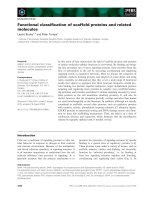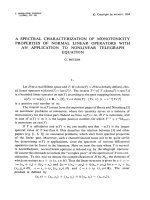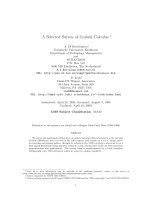Báo cáo toán học: "A classification of Ramanujan unitary Cayley graphs" pot
Bạn đang xem bản rút gọn của tài liệu. Xem và tải ngay bản đầy đủ của tài liệu tại đây (92.17 KB, 6 trang )
A classification of Ramanujan unitary Cayley graphs
Andrew Droll
Submitted: Sep 24, 2009; Accepted: May 18, 2010; Published: May 25, 2010
Mathematics Subject Classification: 05C75
Abstract
The unitary Cayley graph on n vertices, X
n
, has vertex set
Z
nZ
, and two vertices
a and b are connected by an edge if and only if they differ by a multiplicative unit
modulo n, i.e. gcd(a − b, n) = 1. A k-regular graph X is Ramanujan if and only if
λ(X) 2
√
k −1 where λ(X) is the second largest absolute value of the eigenvalues
of the adjacency matrix of X. We obtain a complete characterization of the cases
in which the unitary Cayley graph X
n
is a Ramanujan graph.
1 Unitary Cayley graphs
Given a finite additive abelian group G and a symmetric subset S of G, we define the
Cayley graph X(G, S) to be the graph whose vertex set is G, and in which two vertices v
and w in G are connected by an edge if and only if v − w is in S. A Cayley graph o f the
form X(G, S) with G =
Z
nZ
is called a circulant g r aph.
The unitary Cayley graph on n vertices, X
n
, is defined to be the undirected graph
whose vertex set is
Z
nZ
, and in which two vertices a and b are connected by an edge if and
only if gcd(a −b, n) = 1. This can also be stated as X
n
= X
Z
nZ
,
Z
nZ
∗
, where
Z
nZ
is the
additive group of integers modulo n and
Z
nZ
∗
is the set of multiplicative units modulo
n. It is easy to see that X
n
is a simple, ϕ(n)-regular graph, where ϕ is the Euler t otient
function. Here ϕ(n) is defined by ϕ(1) = 1, and for an integer n > 1 with distinct prime
power factorization p
e
0
0
p
e
1
1
···p
e
t
t
for distinct primes p
0
, ···, p
t
and nonnegative integers
e
0
, ···, e
t
, with t 0, ϕ(n) = p
e
0
−1
0
···p
e
t
−1
t
(p
0
− 1) ···(p
t
− 1).
The eigenvalues of the adjacency matrix of X(G, S) f or an abelian group G and sym-
metric subset S are
λ
m
=
s∈S
χ
m
(s), (1)
for m = 0, ···, |G| − 1, where χ
0
, ···, χ
|G|−1
are the irreducible characters of G (see, for
example, [Murty (2003)]). We therefore have the fo llowing lemma (see [Klot z, W. and
Sander, T. (2007)], f or example).
the electronic journal of combinatorics 17 (2010), #N29 1
Lemma 1.1 The eigenv alues of any adjacency matrix of X
n
are
λ
m
(n) =
a, (a,n)=1
e
2iπam
n
, m = 0, . . . , n − 1. (2)
In fact, these are Ramanujan sums, which are known to have the simpler closed fo rm
λ
m
(n) = µ
n
(n, m)
ϕ(n)
ϕ
n
(n,m)
, (3)
where µ is the M¨obius function and ϕ is the Euler totient function (see [Murty (2003)], for
example). Recall that the M¨obius function µ is defined for positive integers n by µ(n) = 0
if n is not square-free, µ ( n) = 1 if n is square-free and has an even number of distinct
prime factors, and µ(n) = −1 if n is square-free and has an odd number of distinct prime
factors. Since the M¨obius function is zero at non-square-free arguments, the eigenvalue
corresponding to m, 0 m n − 1 is nonzero if and only if
n
(n,m)
is square-free. When
n
(n,m)
is square-free,
|λ
m
(n)| =
ϕ(n)
ϕ
n
(n,m)
. (4)
Recall that the adjacency matrix of any k-regular graph X has eigenvalues between
−k and k, and k is a n eigenvalue with multiplicity precisely equal to the number of
connected components of X. Furthermore, if λ(X) denotes the largest absolute value of
the eigenvalues of the adjacency matrix of X, smaller than k, then the graph X is called
Ramanujan if and only if
λ(X) 2
√
k − 1. (5)
Note that λ(X) is only defined for regular graphs X with 3 or more vertices, so when
discussing X
n
, we always assume n 3. Writing n in the form 2
s
p
e
1
1
p
e
2
2
···p
e
t
t
for some
distinct odd primes p
1
< p
2
< ··· < p
t
, nonnegative integer s, and positive integers
e
1
, ···, e
t
, we can determine λ(X
n
) as follows. Since X
n
is ϕ(n)-regular, we find t he
maximum absolute value of an eigenvalue λ
m
(n) of the adjacency matrix of X
n
, smaller
than ϕ(n). This can be accomplished by looking at (3).
Indeed, we see that if t = 0 then n = 2
s
and the eig envalues have absolute value of
either 0 or ϕ(n) (since the only values of m, 0 m n −1, which make
n
(n,m)
square-free
are m = 0 and m = 2
s−1
, resulting in eigenvalues ϕ(n) and −ϕ(n)). Thus λ(X
2
s
) = 0
and so X
2
s
satisfies (5) and thus is Ra manujan. To consider the case t > 0 , we adopt
the notation max(a, 0) = (a)
+
for any a. Then, if t > 0 and
n
(n,m)
is to be squarefree,
m must clearly be divisible by 2
(s−1)
+
p
e
1
−1
1
p
e
t
−1
t
. Looking at (4), it is apparent that
m = n/p
1
maximizes the absolute value of λ
m
(n) while keeping it smaller than ϕ(n),
since this choice minimizes the quantity ϕ
n
(n,m)
while keeping its value greater than 1,
with
n
(n,m)
square-free (We can not take m = n/2, since ϕ
n
n/2
= ϕ(2) = 1.) Thus for
the electronic journal of combinatorics 17 (2010), #N29 2
t > 0, we have
λ(X
n
) =
ϕ(n)
ϕ
n
(n/p
1
)
=
ϕ(n)
p
1
− 1
(6)
= 2
(s−1)
+
p
e
1
−1
1
···p
e
t
−1
t
(p
2
− 1) ···(p
t
− 1). (7)
We can use this to restate (5) in a simpler form for X
n
when t 1. X
n
is Ramanujan
if and only if
λ(X
n
) =
ϕ(n)
p
1
− 1
2
ϕ(n) − 1. (8)
By noting that (8) implies
ϕ(n)
p
1
−1
< 2
ϕ(n), we easily obtain that a necessary condition
for X
n
to be Ramanujan when t 1 is
ϕ(n)
p
1
− 1
< 4(p
1
− 1). (9)
We now have the tools to state and prove our main result.
Theorem 1.2 The gra ph X
n
is Raman ujan if and only if n satisfies one of the following
conditions fo r some distinct odd primes p < q and natural s.
(a) n = 2
s
, s 2
(b) n = p
(c) n = 2
s
p with s 1, p > 2
s−3
+ 1
(d) n = p
2
, 2p
2
, 4p
2
(e) n = pq , 2pq with p < q 4p −5
(f) n = 4pq with p < q 2p − 3
Proof As in our discussion above, n = 2
s
p
e
1
1
···p
e
t
t
. If t 3 then
ϕ(n)
p
1
− 1
p
e
1
−1
1
p
e
2
−1
2
p
e
3
−1
3
(p
2
− 1)(p
3
− 1) 4(p
1
− 1),
since p
1
< p
2
< p
3
are odd primes, and p
2
− 1 > p
1
− 1 and p
3
− 1 > 4. This violates the
necessary condition (9). Thus we see that if t 3 (i.e. n has at least three distinct odd
prime factors), then X
n
is not Ramanujan.
This shows that any n for which X
n
is Ramanujan must have at most two distinct odd
prime factors, i.e. t 2. We have already shown in our earlier discussion that if t = 0 (i.e.
n = 2
s
, as in case (a)), then X
n
is Ramanuja n. Next, we consider t = 2, i.e. n = 2
s
p
b
q
c
for some distinct odd primes p < q, nonnegative integer s, and positive integers b, c. By
(9), the graph X
n
will not be Ramamujan if
ϕ(n)
p − 1
= 2
(s−1)
+
p
b−1
q
c−1
(q −1) 4(p − 1).
the electronic journal of combinatorics 17 (2010), #N29 3
This inequality holds unless b = c = 1 and s 2, since if s > 2 we have 2
(s−1)
+
4 and
q − 1 > p − 1, and if c > 1 or b > 1, we have q − 1 4 and p
b−1
q
c−1
> p − 1. Thus if
t = 2, X
n
is Ramanujan only if n has the form pq, 2pq, or 4pq. If n = pq or n = 2pq, we
have
ϕ(n)
p−1
= (q − 1), and the Ramanujan condition (8) is
q − 1 =
ϕ(n)
p − 1
2
ϕ(n) −1 = 2
(p − 1)(q −1) −1,
which is easily seen to be equivalent to
q −1 4(p − 1) −
4
q −1
.
Noting tha t p < q are odd primes, and in particular q 5 (so
4
q−1
1), we see that
this implies q 4p −5, as in case ( e) above, and it is straightforward to check that the
converse holds as well. On the other hand, if n = 4pq, we have
ϕ(n)
p−1
= 2(q − 1), and the
Ramanujan condition (8) is
ϕ(n)
p −1
= 2(q − 1) 2
2(p −1)(q −1) − 1 = 2
ϕ(n) − 1,
which, similarly, is equivalent to
q −1 2(p − 1) −
1
q −1
.
Again, we note that p < q are odd primes, and q 5 (so
1
q−1
< 1), to see that the
above line is equivalent to q 2p −3, as in case (f). Thus we see t hat cases (e) and (f)
completely characterize the values of n with exactly two distinct odd prime factors such
that X
n
is Ramanujan, as we wanted.
Finally we must consider t he case t = 1, i.e. n has exactly one odd prime factor. Here
n = 2
s
p
b
for some odd prime p, nonnegative integer s, and positive integer b. If n is prime,
i.e. s = 0, b = 1, then the graph X
n
is easily seen to be the complete graph on n vertices,
which is well-known to be Ramanujan [Murty (2003)]. More generally, with n = 2
s
p
b
, we
see that by (9) , X
n
will not be Ramanujan if
ϕ(n)
p − 1
= 2
(s−1)
+
p
b−1
4(p − 1).
This holds unless b = 1 and s is sufficiently small compared to p, or b = 2 and s 2,
since otherwise, p
b−1
> (p − 1), and 2
s−1
4 for s 3. Suppose b = 2 and s 2.
Since ϕ(2p
2
) = ϕ(p
2
) = p(p − 1), the cases s = 0 and s = 1 are identical, because the
Ramanujan condition (8) depends only on ϕ(n). It is straightforwar d to check that if
n = p
2
or 2p
2
, then
p =
ϕ(n)
p − 1
2
ϕ(n) − 1 = 2
p(p − 1) − 1,
the electronic journal of combinatorics 17 (2010), #N29 4
while if n = 4p
2
, then
2p =
ϕ(n)
p − 1
2
ϕ(n) − 1 = 2
2p(p − 1) − 1,
i.e. the Ramanujan condition (8) is satisfied in t hese three cases, and thus X
p
2
, X
2p
2
,
and X
4p
2
are all Ramanuja n for any odd prime p, as claimed in case (d). The final case
to consider is b = 1 and s 1. In this case n = 2
s
p and
ϕ(n)
p−1
= 2
s−1
. The Ramanujan
condition (8) is
2
s−1
=
ϕ(n)
p − 1
2
ϕ(n) − 1 = 2
2
s−1
(p − 1) − 1,
which is easily r earranged to
p 2
s−3
+ 2
1−s
+ 1 .
Thus we see that for s 1, X
2
s
p
is Ramanujan whenever p 2
s−3
+ 2
1−s
+ 1. Since p 3
is an odd prime, it is easily verified that this is equivalent to p > 2
s−3
+ 1, as claimed in
case (c).
We have now examined all possible cases for the prime decomposition of n, so we are
done.
2 Concluding remarks
We have completely characterized which unitary Cayley graphs a re Ramanujan. We
remark that every case of Theorem 1 gives rise to infinite families of Ramanujan graphs
in this form. As shown by Murty in [Murty (2005)], it is impossible to construct an infinite
family of k-regular abelian Cayley graphs which are all Ramanujan fo r any particular k.
However, finding examples of Ramanujan graphs in the way that we have presented here
is still of some interest. It is also interesting to remark on some other work that has been
done on unitary Cayley graphs. Various pro perties of the gr aph X
n
were determined in
[Klotz, W. and Sander, T. (2007)], including the chromatic number, the clique numb er,
the independence number, the diameter, and the vertex connectivity, in addition to some
work on the eigenvalues. The energy of X
n
was determined and studied independently
in [Ili´c (2009)] and [Ramaswamy, H.N. and Veena, C.R. (2009)]. It is a lso interesting to
note that [Ramaswamy, H.N. and Veena, C.R. (2009)] hints at a new approach to finding
the eigenvalues of X
n
using properties of the graph instead of relying on their expression
as Ramanujan sums.
Another point of interest arises in noting that unitary Cayley graphs are examples
of connected circulant integral graphs. A recent paper by Wasin So (see [So (2005)])
chara cterizes the family of integral circulant graphs, and it is worth noting that this
entire family of graphs may easily be constructed from t he graphs X
n
which we have
discussed in this paper. This fact naturally invites attempting to apply the results of
Theorem 1 to larger families of integral circulant graphs.
For further discussion on the topic of Ramanujan graphs, one is invited to loo k at
[Murty (2003)].
the electronic journal of combinatorics 17 (2010), #N29 5
Acknowledgements
I would like to thank Professor David Gregory for his extensive help in editing this paper
and giving numerous corrections, as well as providing many references to other work on
the subject of unitary Cayley graphs. Additionally, I would like to thank Professor Ram
Murty for his guidance, and for his help with both this pa per, and with my earlier Master’s
thesis from which this discussion arose (o n which I also received help from Professors
David Gregory and Mike Roth). I would also like t o thank all attendants of the Queen’s
University numb er theory seminar for their input and attention at my presentations earlier
this year and last.
References
Ili´c, A. (2009). The energy of unitary Cayley graphs. Linear Algebra and its Applications,
In Press.
Klotz, W. and Sander, T. (2007). Some properties of unitary Cayley graphs. The Elec-
tronic Journal of Combinatorics, 14 , #R45.
Murty, R. (2003). Ramanujan gr aphs. Journal of th e Ramanujan Math. Society, 18 (1),
1–20.
Murty, R. (2005). Ra manujan graphs and zeta functions. In R. Tandon (Ed.) Algebra and
Number Theory : Proceed i ngs of the Silver Jubilee Conference University of Hyderabad,
(pp. 269–280) . Hindustan Boo k Agency, New Delhi.
Ramaswamy, H.N. and Veena, C.R. (2009). On the energy of unitary Cayley graphs. The
Electronic Journal of Combinatorics, 16 , #N24.
So, W. (2005). Integral circulant graphs. Discrete Math., 306 , 153–158 .
the electronic journal of combinatorics 17 (2010), #N29 6









